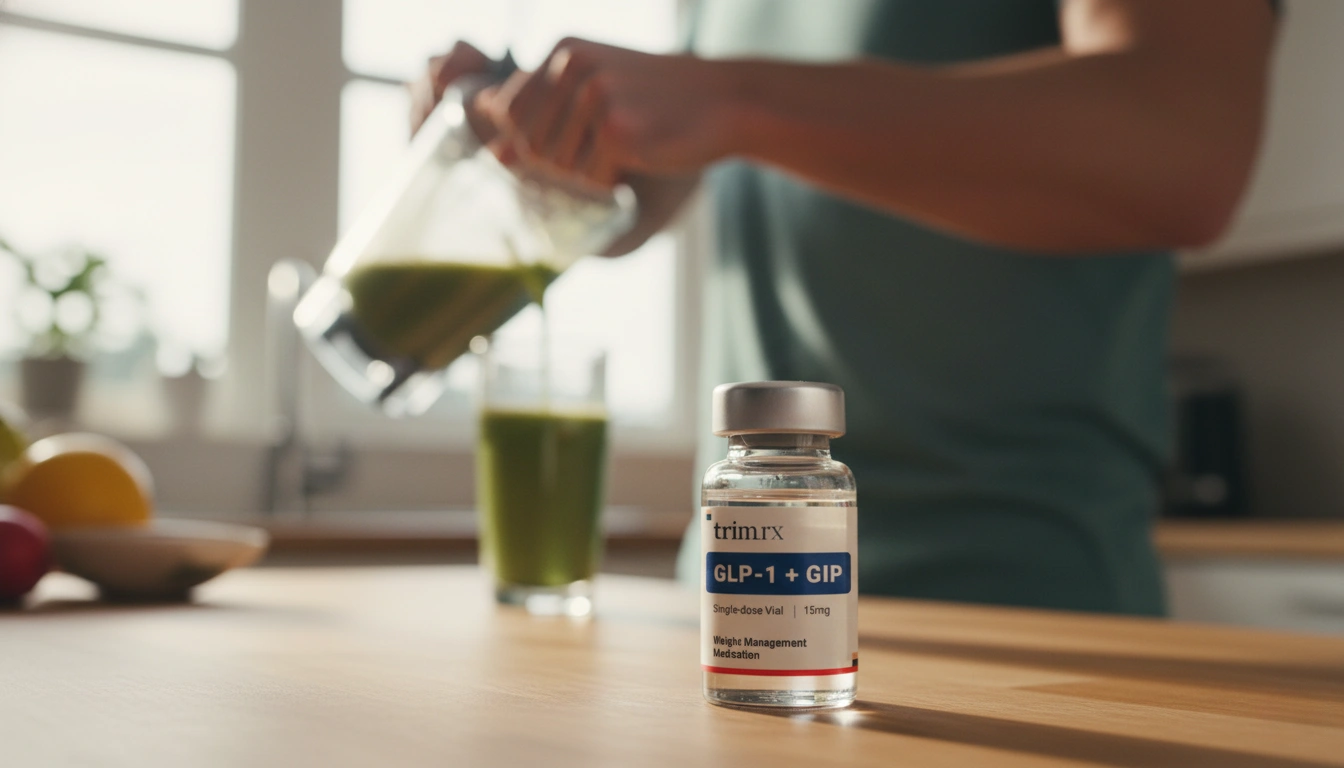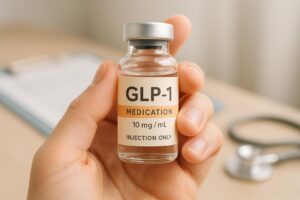What Are GLP-1 Medications Made From and How Do They Work?

When it comes to weight loss and managing diabetes, few innovations have generated as much excitement as glucagon-like peptide-1 (GLP-1) medications. These drugs, which include well-known names like Ozempic® and Wegovy®, have transformed the landscape of treatment for obesity and type 2 diabetes. But what exactly are GLP-1 medications made from, and how do they function within our bodies?
In this post, we will explore the origins of GLP-1 medications, their mechanisms of action, the scientific advancements behind their development, and their role in personalized weight loss solutions. By the end, you will have a deeper understanding of this revolutionary class of drugs and how they can potentially enhance your journey toward a healthier lifestyle.
Introduction
Did you know that obesity and type 2 diabetes affect millions of people worldwide, leading to severe health complications? In the United States alone, the CDC reports that over 40% of adults are classified as obese, a condition that significantly increases the risk for diabetes, heart disease, and other health problems. Given the alarming prevalence of these conditions, it’s no wonder that researchers have been tirelessly working to develop effective treatments. One of the most promising advancements in recent years is the emergence of GLP-1 medications.
These medications mimic a hormone that your body produces in response to eating, designed to help regulate blood sugar levels and promote feelings of fullness. At TrimRx, we are committed to providing personalized, medically supervised weight loss solutions, which is why we believe it is essential to understand the science behind GLP-1 medications.
In this blog post, we will delve into the following aspects of GLP-1 medications:
- The Origins of GLP-1 Medications: What they are made from and how they were developed.
- How GLP-1 Medications Work: The biology behind their effectiveness in managing weight and blood sugar levels.
- Types of GLP-1 Medications: An overview of the various medications available.
- The Role of GLP-1 Medications in Weight Loss: How they help patients achieve healthier weight.
- Safety and Side Effects: What to know before starting treatment with GLP-1 medications.
- Getting Started with TrimRx: How our personalized programs can support your weight loss journey.
By the end of this post, you will not only understand what GLP-1 medications are made from but also how they can be integrated into a successful weight loss strategy, emphasizing our commitment to safe and effective solutions.
The Origins of GLP-1 Medications
GLP-1 medications derive their name from the glucagon-like peptide-1 hormone, which is produced in the intestines. The story of GLP-1 began in the early 1980s when researchers discovered the hormone during studies aimed at understanding how the body regulates blood sugar levels. They found that GLP-1 plays a crucial role in glucose metabolism by stimulating insulin secretion and inhibiting glucagon release.
The active form of GLP-1, which is crucial for its function, is a 30- or 31-amino-acid-long peptide. This peptide is derived from a larger precursor protein called proglucagon, which undergoes post-translational modifications to produce GLP-1. The natural degradation of GLP-1 in the body is rapid, with a half-life of only about two minutes. This poses a challenge for developing medications that can effectively utilize the hormone’s beneficial effects.
To overcome this challenge, pharmaceutical companies have created GLP-1 receptor agonists—synthetic compounds designed to mimic the action of GLP-1 while having a longer half-life. These medications are typically delivered via injection, allowing them to remain in circulation longer and achieve their therapeutic effects.
The first GLP-1 medication, exenatide (Byetta), was approved by the FDA in 2005 for the treatment of type 2 diabetes. Since then, other GLP-1 medications such as liraglutide (Victoza) and semaglutide (Ozempic, Wegovy) have entered the market, further expanding treatment options for individuals managing obesity and diabetes.
How GLP-1 Medications Work
Understanding how GLP-1 medications work requires a closer look at their mechanism of action within the body. GLP-1 is classified as an incretin hormone, meaning it is released in response to food intake and helps regulate blood sugar levels in a glucose-dependent manner. Here are some key functions of GLP-1 and how its medications work:
-
Stimulating Insulin Secretion: When blood sugar levels rise, GLP-1 enhances the secretion of insulin from the pancreas, helping to lower blood glucose levels.
-
Inhibiting Glucagon Release: GLP-1 suppresses the release of glucagon, a hormone that prompts the liver to release stored glucose, thus preventing blood sugar spikes.
-
Slowing Gastric Emptying: GLP-1 delays the emptying of food from the stomach, leading to increased feelings of fullness and reduced appetite.
-
Promoting Satiety: By acting on the brain’s appetite centers, GLP-1 medications help reduce hunger signals, making it easier for individuals to consume fewer calories.
-
Enhancing Beta-Cell Function: GLP-1 promotes the growth and regeneration of insulin-producing beta cells in the pancreas, supporting better glycemic control over time.
These combined effects contribute to lower blood sugar levels and can lead to weight loss, making GLP-1 medications particularly effective for individuals managing type 2 diabetes and obesity.
Types of GLP-1 Medications
GLP-1 medications are available in various formulations, each designed to meet specific patient needs. At TrimRx, we offer several FDA-approved GLP-1 medications, including:
-
Semaglutide: Available as both an injection (Ozempic) and oral tablet (Rybelsus), semaglutide is effective for both diabetes management and weight loss (Wegovy).
-
Liraglutide: This medication is marketed as Victoza for diabetes management and Saxenda for weight loss.
-
Exenatide: Available as Byetta and Bydureon, exenatide is primarily used to treat type 2 diabetes.
-
Tirzepatide: A newer addition to the GLP-1 medication family, tirzepatide (Mounjaro) combines GLP-1 receptor agonism with GIP receptor agonism, offering enhanced glycemic control and weight loss.
Each of these medications requires a prescription and is provided through our personalized weight loss program at TrimRx. To determine if you qualify for our prescription weight loss medications, we encourage you to take our free assessment quiz here.
The Role of GLP-1 Medications in Weight Loss
The effectiveness of GLP-1 medications in promoting weight loss can be attributed to their multifaceted approach to appetite regulation and metabolic control. Studies have shown that individuals using GLP-1 medications can achieve significant weight loss, often exceeding that of traditional weight loss methods.
-
Appetite Suppression: By promoting feelings of fullness and reducing hunger, GLP-1 medications help individuals consume fewer calories without feeling deprived.
-
Behavioral Changes: Many patients report that they develop healthier eating habits while on GLP-1 medications. The altered appetite signals can lead to more mindful eating, encouraging individuals to make better food choices.
-
Sustained Weight Loss: Unlike many weight loss methods that result in temporary changes, GLP-1 medications have shown promise in maintaining weight loss over extended periods. However, the long-term commitment to lifestyle changes is essential for sustained success.
-
Support from TrimRx: At TrimRx, we understand that weight loss is a unique journey for each individual. Our comprehensive service includes doctor consultations, personalized treatment plans, unlimited support, and shipping of medications—all designed to guide you toward your weight loss goals.
To enhance your experience, we also offer quick-access supplements such as GLP-1 Daily Support and Weight Loss Boost, which can be purchased without needing to complete the quiz. You can explore our quick-access supplements here and here.
Safety and Side Effects
While GLP-1 medications are generally well-tolerated, it’s important to be aware of potential side effects. Common side effects include:
-
Gastrointestinal Symptoms: Nausea, vomiting, diarrhea, and constipation are among the most reported side effects. These symptoms can often occur when starting the medication and may improve over time as the body adjusts.
-
Injection Site Reactions: Some individuals may experience redness or irritation at the injection site.
-
Risk of Hypoglycemia: While GLP-1 medications have a lower risk of causing low blood sugar compared to other diabetes treatments, caution is still required, especially in patients taking other medications that can lower blood sugar.
-
Pancreatitis: There have been rare reports of pancreatitis in patients using GLP-1 medications, so it’s essential to monitor any abdominal pain or discomfort.
Before starting any new medication, including GLP-1 medications, we recommend discussing your medical history and any concerns with our healthcare team. Our compassionate approach ensures that we respect your unique journey while prioritizing your safety.
Getting Started with TrimRx
At TrimRx, our mission is to empower individuals to embrace healthier lifestyles through personalized, medically supervised care. If you’re considering GLP-1 medications as part of your weight loss journey, we invite you to take the first step by completing our free assessment quiz here. Based on your responses, we will provide a personalized treatment plan tailored to your specific needs.
Our comprehensive service includes:
-
Doctor Consultations: Our medical professionals will guide you through the process and ensure that you have the right treatment plan to achieve your goals.
-
Personalized Treatment Plans: Each plan is tailored to your individual needs and preferences, focusing on sustainable weight loss.
-
Unlimited Support: Our team is here to support you every step of the way, providing guidance, encouragement, and resources to help you succeed.
-
Shipping with No Hidden Fees: We partner with FDA-registered and inspected pharmacies to deliver your medications safely and efficiently.
Together, we can work toward a healthier, happier you.
Conclusion
GLP-1 medications represent a groundbreaking advancement in the fight against obesity and type 2 diabetes. By mimicking the natural hormone GLP-1, these medications effectively regulate blood sugar levels and promote weight loss through a multifaceted approach. Understanding what GLP-1 medications are made from and how they work is essential for anyone considering them as part of their weight loss journey.
At TrimRx, we are dedicated to supporting your unique path to better health with personalized, medically supervised care. If you’re ready to explore our GLP-1 medication options and see if you’re eligible for our prescription weight loss program, take our free assessment quiz here.
FAQ
What are GLP-1 medications made from?
GLP-1 medications are synthetic forms of the naturally occurring hormone glucagon-like peptide-1, which is produced in the intestines. These medications mimic the hormone’s actions to regulate blood sugar and promote weight loss.
How do GLP-1 medications work?
GLP-1 medications stimulate insulin secretion, inhibit glucagon release, slow gastric emptying, and promote satiety, leading to improved blood glucose control and weight loss.
What types of GLP-1 medications are available?
Common GLP-1 medications include semaglutide (Ozempic, Wegovy), liraglutide (Victoza, Saxenda), exenatide (Byetta, Bydureon), and tirzepatide (Mounjaro).
Are there any side effects associated with GLP-1 medications?
Common side effects include gastrointestinal symptoms like nausea and vomiting, injection site reactions, and a low risk of hypoglycemia. Always consult with a healthcare provider before starting treatment.
How can I get started with GLP-1 medications through TrimRx?
To get started, complete our free assessment quiz here, and we will provide a personalized treatment plan based on your needs.
By understanding GLP-1 medications and their role in weight loss, you can take proactive steps toward a healthier future. Let’s embark on this journey together!

Transforming Lives, One Step at a Time
Keep reading
Tracking Progress With GLP-1: What To Measure
Learn which metrics to track on GLP‑1 therapy—weight, waist, blood sugar, lipids, side effects, and non‑scale wins—and how often to monitor them.
Fatigue Solutions for Ozempic and Wegovy Users
Hydration, protein-rich meals, light activity, and better sleep can reduce medication-related fatigue and help maintain energy during weight-loss treatment.
GLP-1 Medication Side Effect Checker
Worried about GLP-1 medication side effects? Use our free checker for Semaglutide, Liraglutide, and more to learn what to expect and stay informed!



